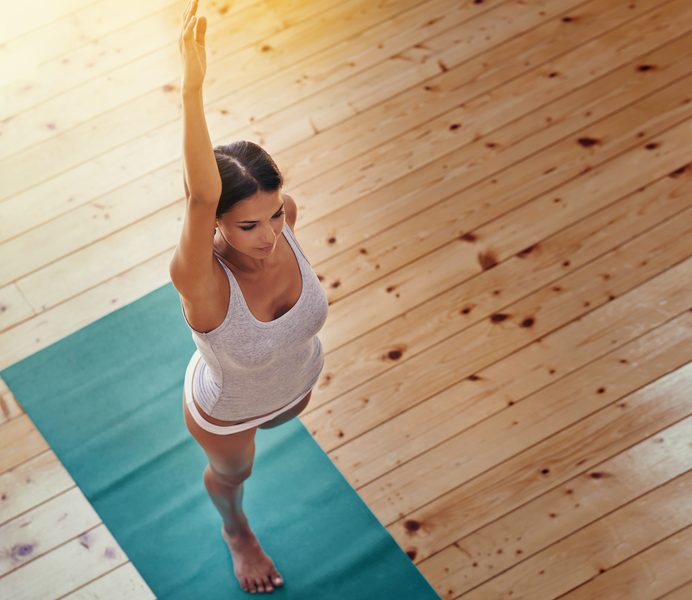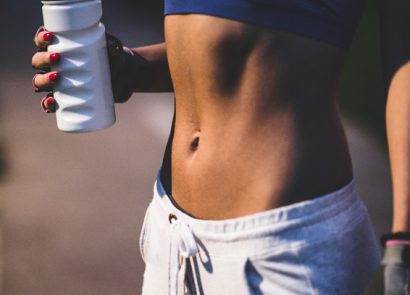The ancient practice of yoga has seen a surge in popularity over the last decade. Even some exercise enthusiasts more at home in the gym or pounding the pavements in running shoes have been reaping the rewards from yoga practise. According to yoga teacher Ronnie Burgess, there are literally hundreds of poses that can provide a workout for any sportsperson’s needs: “The practice of yoga integrates the mind-body association from which any sports enthusiast can benefit tremendously from,” she points out. “Yoga poses are designed to build core strength, which is essential for running as well as other activities. Slow, focused movements call for a strong midriff, and muscular stretches add a new form of resistance training to your regime.”
Regular yoga sessions can enhance flexibility and your range of motion, plus the breathing techniques can improve lung capacity – crucial for high-impact training. “Take running as an example: it can often create imbalances in the body,” says Ronnie. “The muscles that move your legs sideways become weak, while those that are overused become tight. The continual pounding involved in running can also compress your spine. Yoga improves your body’s suppleness and strength, but it also enhances balance and coordination, increases breathing capacity and hones mental focus.”
Reduced injury risk
Injury is any avid exerciser’s greatest fear, as it can leave you unable to train for months at a time. Improved joint and muscle mobility, and better posture – all of which yoga helps with – can help prevent injuries in those who regularly practise high-impact exercise.
Alongside this is the issue of promoting great balance. “Yoga is the ideal way to bring balance exercises into your training regime,” Ronnie points out. “Balance exercises are all too frequently missed out by those who concentrate on cardio. However, they are amongst the most efficient ways to fix any discrepancy in the body, which is crucial, as it’s imbalances that most commonly lead to injury. Most training routines develop some muscle groups but ignore others; yoga can fix these inconsistencies.”
Yoga expert Mollie McClelland (molliemcclelland.com) explains how muscular injury can be prevented: “By increasing flexibility, yoga averts injuries that come from pulling muscles, because the athlete’s range of movement is significantly enhanced,” she says. “Some injuries come from impact or force on the body, but if you have better mobility in your muscles and good balance, the pressure of the force should be minimised.”
Do yoga, be better
“Whatever sport you practise, yoga can help you improve your performance,” claims Ronnie, who says many of her clients have seen an almost immediate improvement in training, both from a psychological and physical perspective. “For example, Pranayama (breathing exercises) and meditation can help you focus your mind and regulate your breathing as well as improve your lung capacity.”
Mollie agrees, as many high calibre athletes regularly do mind training to help them reach top form, and the focus side of yoga is an extension of this: “One aspect of yoga exercise is detachment and being ‘in the moment’ – this type of training for athletes and people who play competitive sports is crucial,” she says. “How do you come back and reach a new personal best? How do you find the power to push through when it seems all power is gone? How do you negotiate a challenge? As mental clarity and compassion for the self develop, we can become increasingly successful in handling difficult moments in our sport.”
Stretch stronger
Yoga teaches proper technique so that you can expand the power of the stretches you do for your specific training. Runners can sometimes be the worst culprits when it comes to not making enough time for stretching after a training session. “The very least that yoga offers runners is a time to stretch really well,” Ronnie tells us. “This is such a crucial – but often forgotten – part of their training.”
Similarly, Mollie is adamant about the benefits of being stretch savvy: “When we stretch without awareness, it is common to compensate for tight places by stretching in places that are already less tight,” she points out. “When you use proper technique, as taught through yoga practise, you can learn to target your stretches to the appropriate places. Also, because many yoga poses have an isometric element, stretching is far safer than if you just push into the depth of a stretch.” So, if you want to boost your performance in your sport, make time for yoga in your weekly routine.
Workout Zen
Yoga expert Mollie McClellend suggests some sport-specific poses to give you a taste for stretch sessions…
Runners
Runner’s lunge, also known as low lunge or Ardha Mandalasana: Bend forward from the hips and step your left leg back. Tuck your toes under so your left leg is straight. Put your hands on the floor or your fingertips on either side of your front foot. Roll your shoulders back and try to flatten your upper back and project your chest forwards, without sticking your chin out. Hold the pose for 5-10 breaths, then switch legs and repeat.
Swimmers
Chest opener on the wall: Take a mat close to a wall, and stand about 8” away from it, with the wall next to your right shoulder. Step your right leg forward into a high lunge or warrior one position. Then, take your right arm and put it on the wall (palm facing the wall) at shoulder height, but behind the shoulder as far as possible. Push against the wall with your hand and spin your chest away from the wall, as you breathe deeply and feel your chest stretching open. Stay for 5-10 deep breaths, then turn around and do the same on the other side.
Cyclists
Ardha Bhekasana (half frog pose), Ardha Dhanurasana (half bow pose): Lying on your belly on the floor, prop yourself up on your forearms so that your elbows are just underneath your shoulders. Then, pull your belly away from the floor, as if there is a needle on the floor that you need to lift away from. Next, bend your right knee then reach around with your right arm to hold your foot and squeeze it in to you. Repeat on your left leg. This stretches your thigh and the fascia around your knee.
Cross Train
Yoga teacher Ronnie Burgess describes how yoga can benefit your specific sport…
Rugby and football:
yoga helps lengthen your hamstrings, quadriceps and groin – common problem areas in these sports
Racket sports:
players may be prone to one-sided or uneven muscle development. Yoga asanas can strengthen weak areas and ease muscular tension. Yoga also promotes clear thinking, useful for fast reactions
Swimming:
breathing exercises can help swimmers regulate their breathing and enhance lung capacity for more efficiency when swimming. Increased flexibility from yoga will make for a more agile swimmer
Cycling:
a cyclist’s back stays in one position for long periods, so the muscles often become tense. This can be remedied with back bends and stretches. Stiffness in the legs can also be eased with stretches
Running:
yoga keeps the leg muscles flexible (hamstrings, hip flexors, shins, calves). It also helps maintain focus in long distances, such as marathon running (some runners find it helpful to chant a mantra internally to help them keep going)
Hiking:
again, yoga stretches tight calves and hamstrings. It can also relieve stiff backs and shoulders from carrying heavy packs
Golf:
a better posture and controlled breathing encourages a more even and relaxed ball address, improving swing
}





















